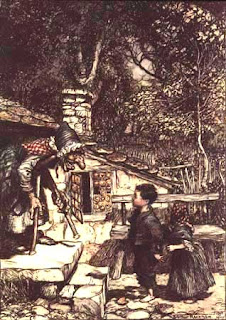First, this week is your LAST chance to register for the Heroines of Fantasy Grand Opening Raffle on October 1. First prize is a free signed copy of the novel Eolyn by Karin Rita Gastreich. Second prize is the October 2010 issue of Adventures for the Average Woman, featuring Karin's short story 'Creatures of Light'. To learn more about the prizes and registering, visit our Grand Opening Raffle Page. Or just send your name and email address to women.writing.fantasy(at)gmail.com
Also, Karin was interviewed this past week by Terra Whiteman at 1889 Labs. To read about what inspired Eolyn, the challenges of writing the novel, and the three things Karin would like to do before she dies (which hopefully won't be any time soon), please visit the 1889 Labs Blog.
Now, onto our main attraction. . .
When Kim, Terri and I started Heroines of Fantasy, there was no doubt in our minds as to the person we wanted as our first guest blogger. Eric T. Reynolds has edited over twenty critically acclaimed anthologies, collections and novels and has had short fiction published in several anthologies. He has also published non-fiction articles about the history of space exploration and technology.
Perhaps most relevant to this blog, Eric is the reason Kim, Terri and I know each other. We came together through his small press Hadley Rillle Books, which was founded in 2005 and is dedicated to publishing quality works of science fiction, fantasy and archeologically accurate historical fiction. Hadley Rille is a busy little press that many people in the genre agree is going places. I think I can speak for all three of us when I say it's been a great pleasure and a source of pride to work with Eric and Hadley Rille. So without further ado, let me turn the stage over to our esteemed editor, Eric T. Reynolds:
About three years ago, just a few years after its founding, Hadley Rille Books inhabited two niches: we published hard science fiction anthologies (and some short works from other subgenres) and I was just beginning to plan for our new Archaeology series. In 2008, I was working with Jenny Blackford on her book, The Priestess and the Slave, and had just made an agreement to publish Buffalito Destiny by Lawrence M. Schoen. Those were to be the first single-author books of our two niches.
Jenny’s, the first book of the new Archaeology series, featured female protagonists in dual stories set in ancient Greece (a subject of Jenny’s specialty). She showed what life was like from a female point-of-view, from a common person who was coping on an individual and community level with the Plague of Athens. This was a unique and accurate way to show the struggles of humanity during the ancient past.
Lawrence’s science fiction novel was his first full length novel set in his popular world of The Amazing Conroy and his buffalito, Reggie, a fun adventure told on several levels, showing among other things how humans (and aliens) cope with their own frailties.
So Hadley Rille Books was all set. We had the new Archaeology series and the new Buffalito series of books to look forward to. I was excited. Then Kim Vandervort approached me at Worldcon in 2008 and pitched her novel to me, a fantasy novel called The Song and the Sorceress. I told her, sure I would consider it. I had, after all, published a short story by her in the anthology Ruins Metropolis and I knew she could write. I told her I hadn’t been publishing much fantasy and wasn’t sure if I was going to go that route, but I wanted to see what she had written so I told her to send it to me.
One chapter into the book, I knew I wanted to publish it. (Naturally, I didn’t tell her that until I finished it.)
So here was a book that, even though from a genre I hadn’t planned on spending much publishing time, I wanted to add to our growing list of fantastic titles. It took me a while to realize why I had wanted to publish it. It was an excellent story, for sure. Kim’s voice was unique and exciting. Her characters were vivid. The mystery and romance in the book were exceptional. But after a while I figured out that it fit into a larger part of the Hadley Rille Books personality for which I’d been searching. Along with Jenny’s unique female characters and settings, and Lawrence’s witty storytelling, Kim’s book showed a new perspective on how a protagonist can grow from naivety to one who manages to conquer the unconquerable, and all without relying on many stereotypes of just how women in fantasy should be. Kim’s book also allowed me to appreciate Jenny’s book even more (and appreciate what Jenny had started for Hadley Rille with her female characters' unique points of view).
It’s hard to describe why I thought this, but that sense of building a new niche became stronger as we’ve continued to add more exceptional titles, including those by Kim’s Heroines of Fantasy sisters, Terri-Lynne DeFino and Karin Rita Gastreich. Each of these authors’ works complements and enhances the others. This “being part of something larger” also continued along the Archaeology and science fiction lines. From those beginnings we’ve developed an overall personality of our novels with unique and overlooked points of view from characters, such as female characters (who aren't always young) that show us perspectives of life from an angle we get to see much too seldom in fiction.
Eric T. Reynolds
Hadley Rille Books
...As a post-script, let me add for our readers: Please feel free to ask Eric any questions you have about small press, editing, or publishing in general. Thanks for stopping by! --Karin

